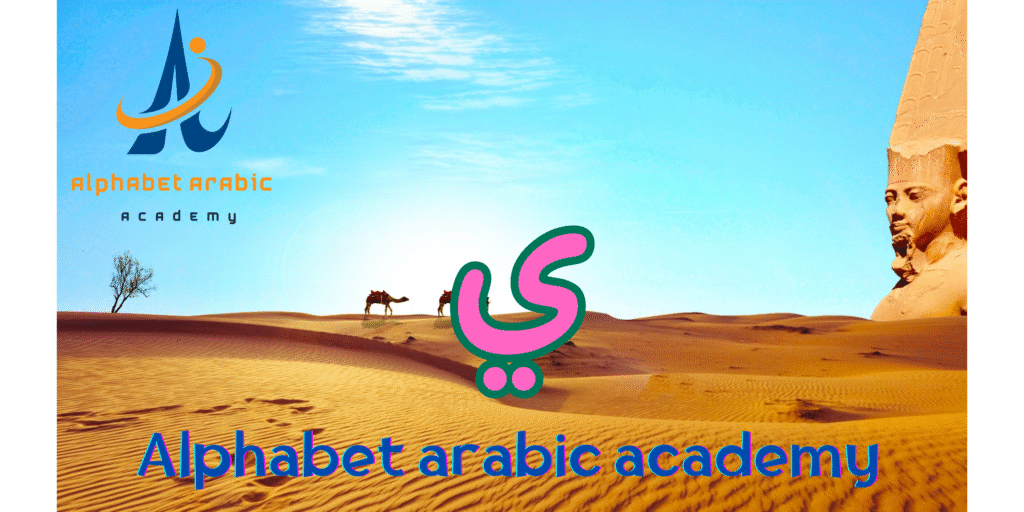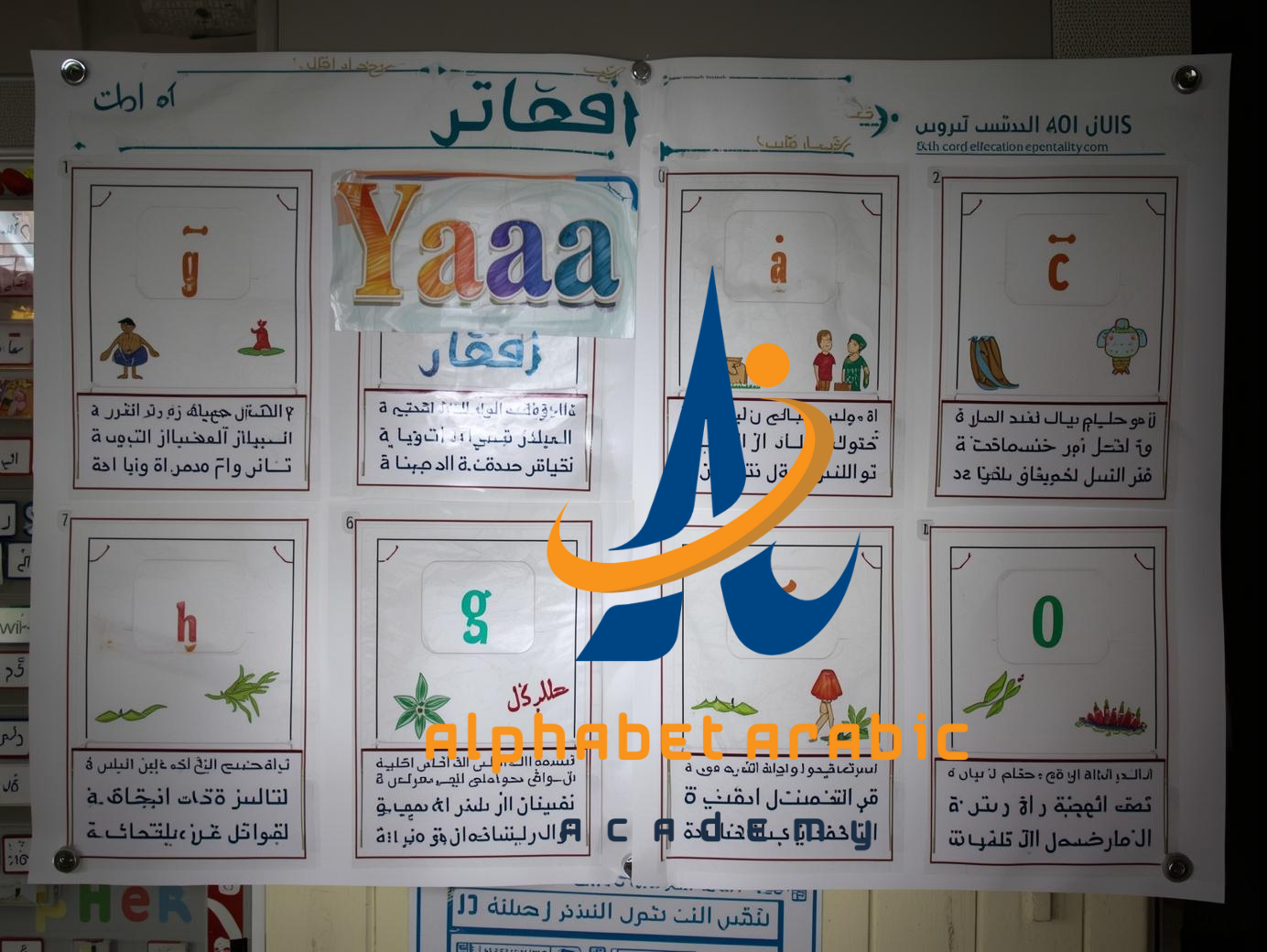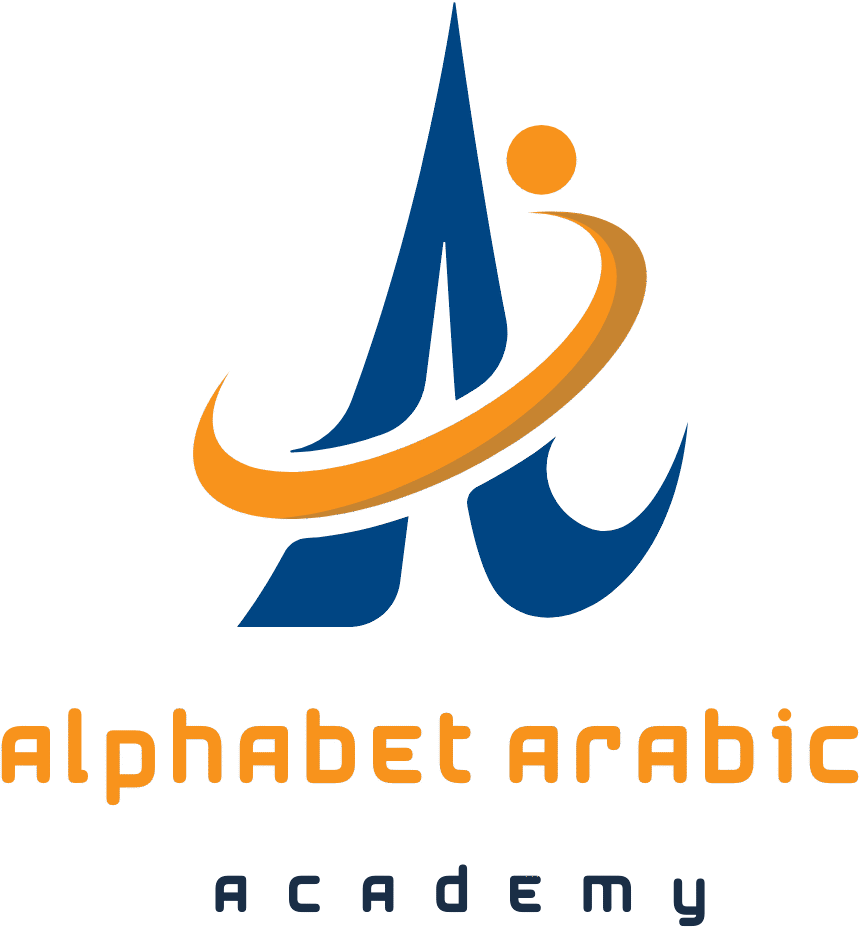Introduction to the Yaa arabic
The Yaa arabic (ي) holds a significant position within the Arabic alphabet, being the twenty-eighth and final letter in the sequence. Characterized by its distinctive tail, Yaa is often compared to the English letter “Y” or the vowel “I,” depending on its placement within a word. Understanding Yaa is crucial for anyone embarking on the journey to master the Arabic language, as it appears frequently in both written and spoken forms.

One unique characteristic of Yaa is its flexibility. It can function as both a consonant and a vowel, a feature that enriches the phonetic diversity of Arabic. When used as a consonant, Yaa sounds similar to the English “Y” as in “yes.” Alternatively, when it acts as a vowel, it can resemble the “ee” sound in “see.” This dual functionality enhances the letter’s versatility and underscores the importance of mastering its various applications.
The pronunciation of Yaa is straightforward yet pivotal in achieving fluency. Beginners should focus on differentiating its consonant and vowel sounds to avoid common pitfalls. Proper enunciation of Yaa can significantly improve one’s clarity and comprehension in Arabic, making it an essential component of language learning. arabic alphabet
Learning the Arabic letter Yaa is not merely an academic exercise; it is a foundational step for anyone looking to engage deeply with the Arabic language. Yaa appears in numerous everyday words, names, and expressions, thereby making it indispensable for effective communication. By mastering Yaa, learners can enhance their reading and speaking abilities, paving the way for more advanced linguistic skills.
In the sections that follow, we will explore various word samples and practical applications of Yaa, providing a comprehensive understanding that will aid in both recognition and usage.
Pronunciation and Phonetics of Yaa
The Arabic letter Yaa, represented as “ي” in its isolated form, is a crucial character in mastering the Arabic language. Pronounced as /j/ in the International Phonetic Alphabet (IPA), it closely resembles the English consonant sound in “yes.” This sound is articulated by placing the tongue against the roof of the mouth, just behind the upper front teeth, and allowing air to pass through, creating a voiced palatal approximant.
To ensure accurate pronunciation, it is beneficial to listen to native speakers and repeat the sounds. Many language learning platforms offer audio samples that can aid in grasping the subtleties of Yaa. Pay particular attention to the tongue’s position and the vocal cord vibration, as these are essential for producing the correct sound.
Common mistakes made by beginners often involve confusing Yaa with other similar-sounding letters, such as Aleph (ا) or Waw (و). Unlike Aleph, which is a glottal stop, or Waw, which is a semi-vowel similar to the English “w,” Yaa requires a more fronted tongue position. Practice can mitigate these errors, and one effective exercise is to alternate between these letters in various combinations to build muscle memory and auditory distinction.
To further refine your pronunciation, consider using articulation exercises. Start by producing the /j/ sound in isolation, then gradually incorporate it into syllables and words. For example, practice with simple words like “يوم” (yawm, meaning “day”) and “يد” (yad, meaning “hand”). Repetition of these exercises will enhance your ability to pronounce Yaa naturally and accurately.
Mastering the pronunciation of Yaa is a stepping stone to fluent Arabic. By paying attention to phonetic details, practicing consistently, and utilizing available resources, learners can overcome initial challenges and integrate this essential letter into their linguistic repertoire effortlessly.
TThe letter Yaa ي with the Harakat حركات:
The letter Yaa ي with fat.ha فتحة:
| ARABIC | ENGLISH | PRONUNCIATION |
|---|---|---|
| ثيَاب | Clothes | Thiyab |
| ريَاضة | Sports | Riyada |
| يَعسوب | Dragonfly | Yaa’sub |
The letter Yaa ي with the Damma ضمة:
| ARABIC | ENGLISH | PRONUNCIATION |
|---|---|---|
| بيُوت | Houses | Buyut |
| يُوسفي | Tangerine | Yusifi |
| عيون | Eyes | Ou’un |
The letter Yaa ي with Kasra كسرة:
| ARABIC | ENGLISH | PRONUNCIATION |
|---|---|---|
| جيِّد | Good | Jayyed |
| سيِّء | Bad | Sayee‘ |
| قيِّم | Valuable | Qayyem |
The letter Yaa ي with Sukuun سكون:
| ARABIC | ENGLISH | PRONUNCIATION |
|---|---|---|
| حليْب | Milk | Halib |
| قميْص | Shirt | Qamis |
| عيْن | Eye | Ayin |
Writing the Letter Yaa in Different Forms
The Arabic letter Yaa (ي) has distinct forms depending on its position within a word. Understanding these variations is crucial for accurate writing and reading. This section will explore the different forms of Yaa when it appears at the beginning, middle, and end of words, as well as its isolated form. Detailed diagrams and step-by-step guides are provided to assist learners in mastering these variations.
Firstly, the isolated form of Yaa is written as (ي) and is used when the letter stands alone, disconnected from any other letters. This form is essential for recognizing the letter in its purest state, particularly when practicing individual letter writing.
When Yaa appears at the beginning of a word, it is written as (يـ). For instance, in the word “يوم” (yawm), which means “day,” Yaa is at the start and takes on this initial form. This form is characterized by a single stroke with a dot below it, followed by a connecting line to the next letter.
In the middle of a word, Yaa is written as (ـيـ). For example, in the word “سيارة” (sayyarah), meaning “car,” Yaa is situated between the letters seen and raa, and it adopts this medial form. Here, Yaa connects smoothly to both preceding and following letters, ensuring the word’s flow is maintained.
When Yaa appears at the end of a word, it is written as (ـي). An example is the word “كرسي” (kursi), which translates to “chair.” In this terminal position, Yaa connects to the preceding letter but ends without extending to any subsequent letters.
Practicing these forms through consistent writing exercises will significantly enhance your proficiency in using the letter Yaa correctly in various word positions. Utilize the provided diagrams and step-by-step guides to refine your skills and build confidence in your Arabic writing abilities.
Common Words Starting with Yaa
Mastering the Arabic letter Yaa (ي) is essential for anyone looking to enhance their Arabic vocabulary. Numerous commonly used words in the Arabic language start with Yaa, each adding a unique dimension to everyday conversations. Below are some frequently used words that begin with Yaa, along with their English translations, pronunciation guides, and example sentences to help you understand their practical applications.
1. يَد (Yad) – Hand
Pronunciation: /jad/
Example Sentence: يَدُهُ قَوِيَّةٌ. (Yaduhu qawiyyatun.) – His hand is strong.
The word “يَد” is a fundamental noun used in various contexts, from daily conversations to literature and formal speech.
2. يَوم (Yawm) – Day
Pronunciation: /jawm/
Example Sentence: كُلُّ يَومٍ أَذْهَبُ إِلَى العَمَلِ. (Kullu yawmin adhhabu ila al-‘amal.) – I go to work every day.
“يَوم” is an indispensable term for discussing time, scheduling, and daily activities, making it a pivotal part of the Arabic lexicon.
3. يَسار (Yasar) – Left
Pronunciation: /jasar/
Example Sentence: إتِّجِهْ إلى اليَسارِ. (Ittajih ila al-yasar.) – Turn to the left.
“يَسار” is often used in giving directions and is crucial for navigation and understanding spatial orientation in Arabic-speaking regions.
4. يَمين (Yameen) – Right
Pronunciation: /jameen/
Example Sentence: يَدُهُ اليُمْنَى. (Yaduhu al-yumna.) – His right hand.
Similar to “يَسار,” the term “يَمين” is essential for directional instructions and spatial awareness.
5. يَتيم (Yateem) – Orphan
Pronunciation: /jateem/
Example Sentence: هُوَ يَتيمٌ بَعدَ وَفاةِ وَالِدَيهِ. (Huwa yateemun ba’da wafati walidayhi.) – He is an orphan after the death of his parents.
The word “يَتيم” holds significant emotional and cultural weight, often appearing in literature, social discussions, and charitable contexts.
These examples illustrate the versatility and importance of the letter Yaa in the Arabic language. Through these words, learners can not only expand their vocabulary but also gain deeper insights into the practical usage of Yaa in various contexts. Understanding these common words is a stepping stone toward fluency and comprehensive language proficiency.
Words Containing Yaa in the Middle Position
To effectively learn the Arabic letter Yaa (ي) and its usage within words, it is crucial to examine its placement in the middle of words. Recognizing Yaa in various contexts will enhance your understanding of its fluid integration and help you become more proficient in reading and writing Arabic.
One example of a word with Yaa in the middle is “بيت” (bayt), which means “house.” Here, Yaa connects seamlessly to the preceding and following letters, demonstrating its flexibility. Another example is “عين” (ʿayn), translating to “eye.” In this word, Yaa is positioned between the letters Ain (ع) and Noon (ن), maintaining the word’s structural integrity while contributing to its phonetic composition.
Consider the word “سيارة” (sayyaara), which stands for “car,” features Yaa between Seen (س) and Raa (ر), showcasing its role in forming the word’s meaning and sound.
By examining these examples, learners can see how Yaa functions within the structure of Arabic words, adapting to various positions while maintaining its distinctive shape. Such practice is beneficial for developing a more comprehensive understanding of Arabic script and its intricate letter formations.
Moreover, practicing with words like “رياضة” (riyaaḍa), meaning “sport,” and “مدينة” (madiina), translating to “city,” will provide further insight into the versatility of Yaa in the middle position. These words highlight the letter’s integration into everyday vocabulary, offering practical applications that reinforce learning.
In summary, paying close attention to words containing Yaa in the middle position helps learners recognize its presence and understand its role within Arabic words. This recognition is fundamental for reading fluency and writing accuracy in the Arabic language.
Words Ending with Yaa
Understanding words that end with the Arabic letter Yaa (ي) is crucial for mastering the Arabic language. The letter Yaa often appears at the end of words, adding specific phonetic and grammatical nuances. Here are some commonly used Arabic words that end with Yaa, along with their meanings and example sentences to aid comprehension and usage.
باقي (Baqi) – Remaining
Example: الطعام الباقي على الطاولة يحتاج إلى التبريد. (The remaining food on the table needs refrigeration.)
قوي (Qawi) – Strong
Example: الرياح القوية تسببت في إلحاق أضرار بالمباني. (The strong winds caused damage to the buildings.)
علي (Ali) – High or Elevated
Example: الجبال العالية مغطاة بالثلوج البيضاء. (The high mountains are covered with white snow.)
كبير (Kabir) – Big
Example: البيت الكبير يحتوي على العديد من الغرف. (The big house has many rooms.)
These examples illustrate the versatility of words ending with Yaa. Recognizing these words in various contexts will significantly enhance your Arabic vocabulary and comprehension. By practicing these words, learners can improve their ability to identify and correctly use words ending with Yaa, thereby achieving better fluency in the language.
Interactive exercises and practice activities play a crucial role in mastering the Arabic letter Yaa. These engaging methods are designed to reinforce learning and ensure practical application. One effective exercise is the fill-in-the-blank activity, where learners complete sentences by inserting the correct form of Yaa. This helps in understanding its contextual usage and solidifying recognition skills.
Another beneficial activity is matching games. These games involve pairing words containing Yaa with their corresponding images or definitions. Such visual and cognitive associations aid in memorization and enhance vocabulary retention. Additionally, these games can be made progressively challenging, ensuring that learners are continually pushed to improve.
Pronunciation drills are indispensable for mastering the correct articulation of Yaa. These drills can be conducted using audio recordings, where learners listen and repeat after native speakers. This not only improves pronunciation but also tunes the ear to the subtle nuances of the Arabic language. Repetition and consistent practice are key to achieving fluency and accuracy in pronunciation.
To further cement understanding, incorporating digital platforms that offer interactive exercises can be highly effective. Many apps and websites provide tailored practice activities that adapt to the learner’s pace and level. These platforms often include instant feedback mechanisms, allowing learners to correct mistakes in real-time and track their progress.
Group activities and peer interactions also play a significant role in language acquisition. Participating in discussions and collaborative exercises encourages practical application and builds confidence. Activities like role-playing or conversational practice sessions where Yaa is frequently used can simulate real-life scenarios, enhancing practical language skills.
In summary, a combination of fill-in-the-blank exercises, matching games, pronunciation drills, digital platforms, and group activities provides a comprehensive approach to mastering the Arabic letter Yaa. These interactive and practice-based methods ensure that learners not only understand the theoretical aspects but also apply their knowledge effectively in practical contexts.
Conclusion and Next Steps
As we have explored, the Arabic letter Yaa (ي) holds a significant place in the Arabic alphabet. From its unique pronunciation to its diverse forms in different word positions, understanding Yaa is essential for mastering the Arabic language. We have delved into various word samples that employ Yaa, highlighting its role in both everyday vocabulary and more complex expressions. This foundation not only aids in recognizing Yaa but also enhances overall Arabic reading and writing skills.
To continue your journey in learning Arabic, consistent practice is key. Regularly writing and pronouncing words containing Yaa will solidify your grasp of the letter. Additionally, engaging with Arabic texts, such as children’s books, newspapers, and online articles, can provide practical exposure and reinforce your learning.
For further reading, consider exploring comprehensive Arabic language textbooks that offer structured lessons and exercises. Online platforms like Duolingo, Rosetta Stone, and Babbel also provide interactive courses tailored to different proficiency levels. Websites like AlJazeera Learning and BBC Languages offer free resources, including video tutorials and practice drills, to support your learning process.
Joining an Arabic language community, whether through local language clubs or online forums, can be immensely beneficial. Such communities provide opportunities to practice conversational Arabic with native speakers and fellow learners. Participating in language exchange programs or finding a language partner can further enhance your speaking and listening skills.
Incorporate Arabic into your daily routine by setting aside dedicated time for study and practice. Utilize flashcards, mobile apps, and language games to make learning engaging and effective. Remember, the journey to mastering Arabic is gradual, and persistence will yield significant progress.
With the resources and strategies mentioned, you are well-equipped to continue your exploration of the Arabic language. Embrace each step of the learning process, and soon, the Arabic letter Yaa, along with the rest of the alphabet, will become second nature. Happy learning!
also read
Are you ready to increase your Arabic skills? Explore our engaging Arabic Lessons for Beginners starting at just $40. Visit our website at Alphabet Arabic Academy for more comprehensive resources. For personalized guidance, please fill our booking form on the Contact Us form.
For detailed pricing options, check out:
Stay connected with us on social media for the latest updates, tips, and interactive content. Embrace the beauty of every letter, discover the hidden in every stroke, and let your journey in Arabic begin today!
Happy learning!






